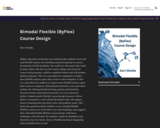
Short Description:
Higher education institutions are realizing that students want and need flexible options for attending and participating in courses. During the COVID pandemic, the world saw that many jobs could be done online. We also saw how many college and university courses and programs could be completed online and still produce quality graduates. This set a precedent for employees to expect more flexible options upon their return to the workplace. It also set a precedent for students to request more flexible options upon their return to campuses. Educational institutions can reach more students by offering flexible learning options and therefore, increase revenue and maintain growth, so it is an attractive option. Students prefer flexible course design because it allows them to customize a work-school-life balance that will support them in meeting their personal, work, and academic goals. This book asks questions about whether or not trimodal flexible (HyFlex) courses are worth their costs and challenges and suggests that a bimodal flexible (ByFlex) course design, with fewer challenges, will still meet the students' needs for flexibility and, therefore, may be a better choice. Flexible learning is happening and is probably here to stay!
Word Count: 21435
(Note: This resource's metadata has been created automatically by reformatting and/or combining the information that the author initially provided as part of a bulk import process.)
- Subject:
- Business and Communication
- Education
- Higher Education
- Special Education
- Material Type:
- Textbook
- Provider:
- Kerri Shields
- Author:
- Kerri Shields
- Date Added:
- 06/12/2023